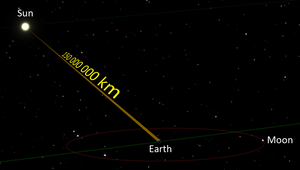Bilis ng liwanag
 Ang liwanag ng araw ay tumatagal ng mga 8 minuto at 19 na segundo upang maabot ang daigdig(batay sa aberaheng distansiya). | |
| Exact values | |
|---|---|
| Metres per second | 299792458 |
| Planck units | 1 |
| Approximate values | |
| kilometres per second | 300,000 |
| kilometres per hour | 1,080 million |
| miles per second | 186,000 |
| miles per hour | 671 million |
| astronomical units per day | 173 |
| Approximate light signal travel times | |
| Distance | Time |
| one foot | 1.0 ns |
| one metre | 3.3 ns |
| from geostationary orbit to Earth | 119 ms |
| the length of Earth's equator | 134 ms |
| from Moon to Earth | 1.3 s |
| from Sun to Earth (1 AU) | 8.3 min |
| from nearest star to Sun (1.3 pc) | 4.2 years |
| from the nearest galaxy (the Canis Major Dwarf Galaxy) to Earth | 25,000 years |
| across the Milky Way | 100,000 years |
| from the Andromeda Galaxy to Earth | 2.5 million years |
Ang bilis ng liwanag o ilaw (Ingles: speed of light) sa isang bakyum na may simbolong c ay isang pisikal na konstante na mahalaga sa maraming aspeto ng pisika. Ang halaga nito ay 299,792,458 metro bawat segundo na isang pigura na eksakto dahil ang haba ng isang metro ay inilalarawan ng konstanteng ito at ng internasiyonal na batayan para sa oras.[1] Ang bilis na ito ay matatantiyang 186,282 milya bawat segundo. Ayon sa Espesyal na teoriya ng relatibidad, ang bilis ng liwanag(c) ang pinakamataas na bilis kung saan ang lahat ng enerhiya, materya, at iba bang pisikal na impormasyon sa uniberso ay maaaring maglakbay. Eto ang bilis ng lahat ng walang masang mga partikulo(massless particle) at mga kaugnay na field kabilang na ang radiasyong elektromagnetiko gaya ng liwanag(light) sa bakyum. Ito rin ang hinulaang bilis ng grabidad o mga along grabitasyonal. Ang mga gayong partikulo ay naglalakbay sa c kahit hindi isaalang alang ang galaw ng pinamulan(source o ang inersiyal na balangkas ng reperensiya(intertial frame of reference) ng isang nagmamasid. Sa Espesyal na teoriya ng relatibidad, ang c ang naguugnay ng espasyo-oras at ito ay makikita sa kilalang ekwasyon ng E = mc2.[2]
Sanggunian
- ↑ Penrose, R (2004). The Road to Reality: A Complete Guide to the Laws of the Universe. Vintage Books. pp. 410–1. ISBN 9780679776314.
... the most accurate standard for the metre is conveniently defined so that there are exactly 299,792,458 of them to the distance travelled by light in a standard second, giving a value for the metre that very accurately matches the now inadequately precise standard metre rule in Paris.
- ↑ Uzan, J-P; Leclercq, B (2008). The Natural Laws of the Universe: Understanding Fundamental Constants. Springer. pp. 43–4. ISBN 0387734546.